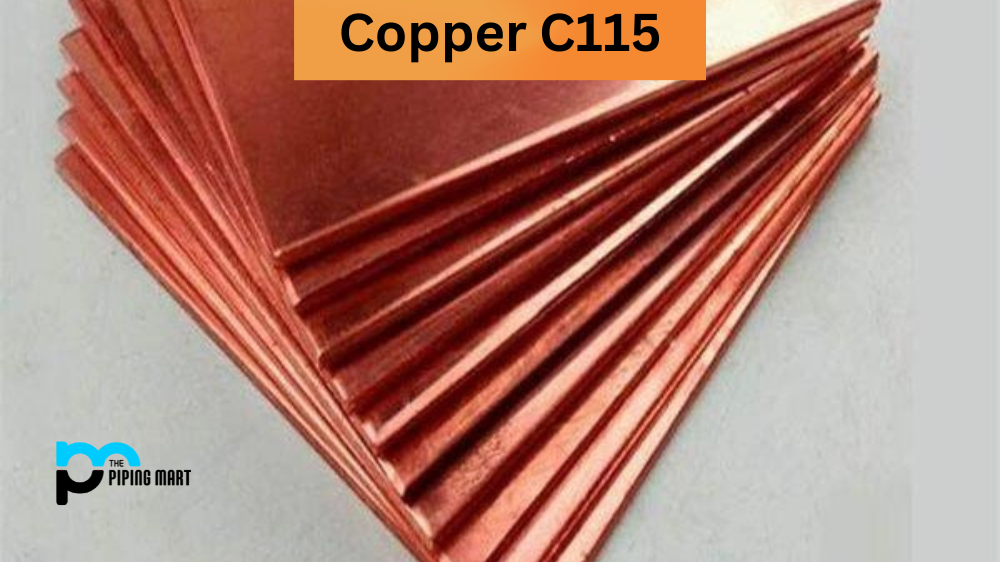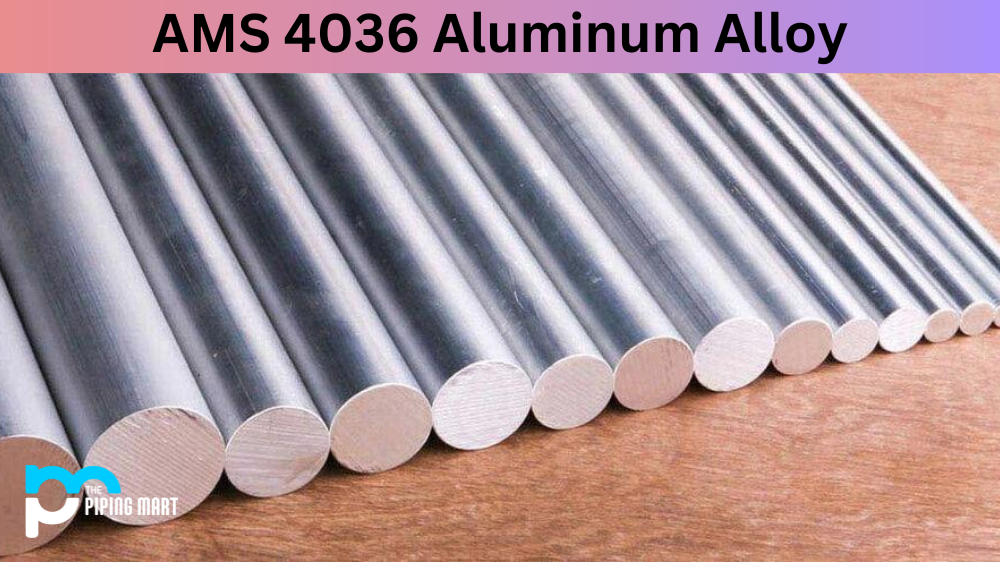C11500 is a copper alloy with excellent strength and ductility. It is widely used in many applications, from the production of coins and electrical components to structural parts and marine hardware. This article will explore the composition, physical properties, uses, corrosion resistance, heat resistance, heat treatment, machining, and welding of Copper C115.
C115 Copper Composition
The composition of C11500 consists mainly of copper (99%), phosphorus (0.15%), and iron (0.20%). This combination gives it excellent strength and ductility characteristics.
| Nominal | Minimum | Maximum | |
|---|---|---|---|
| Copper + Silver | — | 99.90 | — |
| Silver | — | 16oz./ton* | — |
| Oxygen | .04 | — | — |
C115 Copper Chemical Properties
C11500 is an alloy of copper and zinc, with a small yet essential concentration of nickel that makes it ideal for use in industrial applications. Its superior strength and ductility give this alloy enhanced wear resistance, heat tolerance, and corrosion resistance under varying temperatures. These qualities make copper C115 suitable for a wide range of uses, from the piping to aerospace equipment. Moreover, its superior thermal conductivity ensures efficient heat transfer, which is critical in the design and development of electronics. The versatility of copper C115 makes it a must-have material for countless applications in numerous industries ranging from automotive to construction.
C115 Copper Physical Properties
Copper C115 has a density of 8.89 g/cm3, an ultimate tensile strength of 220 MPa (32000 psi), and a modulus of elasticity of 100 GPa (14500 ksi). Its thermal conductivity is 380 W/m-K at 20°C (68°F). Its melting point is 1083°C (1981°F), and its coefficient of thermal expansion is 17 μm/m-K at 20 – 100 °C (68 – 212 °F).
| English Units | C.G.S. Units | |
|---|---|---|
| Melting Point (Liquidus) | 1,980°F | 1,082°C |
| Melting Point (Solidus) | ||
| Density | .321-.323 lb./cu. in. @ 68°F | 8.89-8.94 gm./cu. cm. @ 20°C |
| Specific Gravity | 8.89-8.94 | 8.89-8.94 |
| Coefficient of Thermal Expansion | .0000098 per °F from 68°F to 572°F | .0000177 per °C from 20°C to 300°C |
| Thermal Conductivity | 224 Btu./sq. ft./ft./hr./°F @ 68°F | .927 cal /sq. cm /cm /seC /°C @ 20°C |
| Electrical Resistivity (Annealed) | 10.4 Ohms (cirC mil./ft.) @ 68°F | 1.72 Microhm-cm @ 20°C |
| Electrical Conductivity* (Annealed) | 100% IACS @ 68°F | .580 Megohm-cm @ 20°C |
| Thermal Capacity (Specific Heat) | .092 Btu./lb./°F @ 68°F | .092 cal /gm./°C @ 20°C |
| Modulus of Elasticity (Tension) | 17,000,000 psi | 12,000 Kg./sq. mm. |
| Modulus of Rigidity | 6,400,000 psi | 4,500 Kg./sq. mm |
C115 Copper Mechanical Properties
Copper is an extremely versatile metal used in a variety of applications, including electrical wiring and construction materials. Copper C115 is a unique variety of copper that offers greater strength and increased durability relative to other varieties of this element. Its mechanical properties make it ideal for use in heavily-loaded components, such as gears and screws. Its high plasticity means that it deforms readily under applied pressure but retains its shape when these loads are removed. This trait makes Copper C115 an especially attractive choice for marine applications, where parts must be able to withstand the repeated thrashing of rough seas without suffering any permanent deformation or distortion.
| Size Section | Temper | Tensile Strength psi | Yield Strength (.5% Extension Under Load) psi | Reduction of Area % | Elongation in 2” % | Rockwell Hardness | Shear Strength psi | Fatigue Strength | |||
|---|---|---|---|---|---|---|---|---|---|---|---|
| F | B | 30T | psi | Million Cycles | |||||||
| Flat Products | |||||||||||
| 0.040 in. | 0.025 mm | 34,000 | 11,000 | — | 45 | 45 | — | — | 23,000 | — | — |
| Eighth Hard | 36,000 | 28,000 | — | 30 | 60 | 10 | 25 | 25,000 | — | — | |
| Quarter Hard | 38,000 | 30,000 | — | 25 | 70 | 25 | 36 | 25,000 | — | — | |
| Half Hard | 42,000 | 36,000 | — | 14 | 84 | 40 | 50 | 26,000 | — | — | |
| Hard | 50,000 | 45,000 | — | 6 | 90 | 50 | 57 | 28,000 | — | — | |
| Spring | 55,000 | 50,000 | — | 4 | 94 | 60 | 63 | 29,000 | — | — | |
| Extra Spring | 57,000 | 53,000 | — | 4 | 95 | 62 | 64 | 29,000 | — | — | |
| As Hot Rolled | 34,000 | 10,000 | — | 45 | 45 | — | — | 23,000 | — | — | |
| 0.250 mm | 0.050 mm | 32,000 | 10,000 | — | 50 | 40 | — | — | 22,000 | — | — |
| Eighth Hard | 36,000 | 28,000 | — | 40 | 60 | 10 | — | 25,000 | — | — | |
| Quarter Hard | 38,000 | 30,000 | — | 35 | 70 | 25 | — | 25,000 | — | — | |
| Hard | 50,000 | 45,000 | — | 12 | 90 | 50 | — | 28,000 | — | — | |
| As Hot Rolled | 32,000 | 10,000 | — | 50 | 40 | — | — | 22,000 | — | — | |
| 1.0 in. | Hard | 45,000 | 40,000 | — | 20 | 85 | 45 | — | 26,000 | — | — |
C115 Copper Thermal Properties
| Treatment | Minimum* | Maximum* | ||
|---|---|---|---|---|
| * Temperature is measured in Fahrenheit. | ||||
| Annealing | 900 | 1400 | ||
| Hot Working Temperature | 1400 | 1600 | ||
C115 Copper Equivalent
- ASTM B1
- ASTM B172
- ASTM B174
- ASTM B623
- SAE J461
- QQ W343
- ASTM B355
Copper C115 Uses
Copper C115 is widely used in many different industries for its superior strength and ductility characteristics. It is used in the production of coins as well as various electrical components such as switchgear and relays. It can also be used for structural parts such as heavy-duty machinery frames or housings, valves or flanges, as well as marine hardware like bolts or studs which are exposed to harsh environments.
Corrosion Resistance
Copper C115 offers good corrosion resistance to atmospheric weathering conditions due to its high level of chromium content, which provides a barrier against oxidation. It also offers good resistance to many acids but may corrode when exposed to strong oxidizing agents such as nitric acid or ammonia solutions.
Heat Resistance
Copper C115 has excellent heat resistance up to 300°C (572°F). At higher temperatures, it begins to lose some of its mechanical properties, so it should not be used for applications that require temperatures above 300°C (572°F).
Heat Treatment
Heat-treating Copper C115 can improve its hardness and strength by increasing the rate at which the alloy cools after being heated above its recrystallization temperature range. This process should only be done by experienced professionals who are familiar with the correct techniques needed for successful heat treatment results.
Machining
Machining Copper C115 requires special attention due to its high levels of hardness and toughness, which may cause excessive tool wear during machining operations if proper techniques are not employed correctly. Properly sharpened tools must be used along with low cutting speeds, and generous amounts of cutting fluid must be applied to the workpiece during machining operations in order to achieve satisfactory results without causing excess wear on tools or deformation on the workpiece itself.
Welding
Welding copper alloys like copper c 115 requires special attention due to their high levels of hardness and toughness, which can cause excessive distortion during welding operations if not done correctly. Properly sharpened tools must be used along with low preheat temperatures, low heat input rates, and generous amounts of shielding gas. Specialized filler materials must be chosen depending on the type of weld joint being performed in order to achieve satisfactory results without causing excess distortion on the workpiece itself.
Conclusion
As you can see, copper c 115 offers a wide range of benefits for many different types of applications ranging from coins production, electrical components, structural parts, marine hardware etc. Thanks to its excellent strength, ductility, corrosion resistance, and heat resistance capabilities, this alloy can perform exceptionally well even under extreme conditions making it an ideal choice for those looking for a reliable material capable enough to handle any task they throw at it. With proper heat treatment, machining, and welding techniques, this alloy can offer great results every time, making it the best option available out there. So if you’re looking for an all-purpose material capable enough to handle any type of application, don’t forget about copper c 115!
Sakshee is a talented blogger, with a particular focus on the Business and Metal Industry. She is passionate about sharing her insights on various metal products and helping professionals to make a better decisions.




